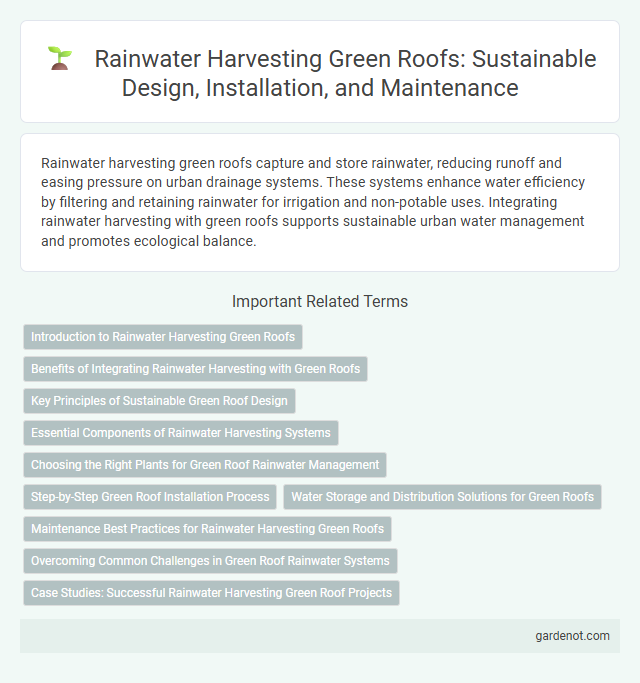Rainwater harvesting green roofs capture and store rainwater, reducing runoff and easing pressure on urban drainage systems. These systems enhance water efficiency by filtering and retaining rainwater for irrigation and non-potable uses. Integrating rainwater harvesting with green roofs supports sustainable urban water management and promotes ecological balance.
Introduction to Rainwater Harvesting Green Roofs
Rainwater harvesting green roofs integrate vegetation with advanced water collection systems to capture and store rainwater efficiently. These eco-friendly roofs reduce stormwater runoff, mitigate urban heat islands, and provide supplementary irrigation for plants. By combining sustainable landscaping with water management, rainwater harvesting green roofs promote resource conservation and enhance urban environmental health.
Benefits of Integrating Rainwater Harvesting with Green Roofs
Integrating rainwater harvesting with green roofs significantly reduces stormwater runoff by capturing and storing rainwater for irrigation and other non-potable uses, promoting water conservation and reducing demand on municipal systems. This synergy enhances urban heat island mitigation by improving substrate moisture retention, which boosts plant health and optimizes cooling effects. Moreover, collected rainwater minimizes the risk of sewer overflows and contributes to sustainable urban water management strategies.
Key Principles of Sustainable Green Roof Design
Rainwater harvesting green roofs optimize stormwater management by capturing and storing rainwater for reuse, reducing runoff and alleviating urban flooding. Key principles include selecting water-retentive substrates, integrating efficient drainage layers, and incorporating vegetation adapted to local climate conditions to maximize water retention and filtration. Sustainable design prioritizes modular systems that balance weight, durability, and ecological benefits, enhancing overall environmental performance.
Essential Components of Rainwater Harvesting Systems
Rainwater harvesting green roofs integrate essential components such as a waterproof membrane, a drainage layer, a filter fabric, and a water storage tank to efficiently capture and utilize rainwater. The waterproof membrane prevents water from seeping into the building structure, while the drainage layer ensures excess water flows to the storage system, promoting optimal water retention. Filter fabrics prevent debris from clogging the system, and storage tanks enable collected rainwater to be reused for irrigation, reducing dependency on municipal water sources.
Choosing the Right Plants for Green Roof Rainwater Management
Selecting drought-tolerant and native plant species enhances the efficiency of green roofs in rainwater harvesting by optimizing water absorption and minimizing runoff. Deep-rooted plants improve soil structure and increase retention capacity, while succulents reduce evaporation rates, contributing to sustainable rainwater management. Proper plant selection directly supports urban flood mitigation and promotes biodiversity in green roof ecosystems.
Step-by-Step Green Roof Installation Process
Rainwater harvesting green roofs begin with the installation of a waterproof membrane to protect the building structure from water intrusion. Next, a root barrier and drainage layer are added to manage excess water and promote healthy plant growth. Finally, a lightweight growing medium is spread, followed by the selection and planting of suitable vegetation to optimize rainwater retention and filtration.
Water Storage and Distribution Solutions for Green Roofs
Rainwater harvesting green roofs utilize advanced water storage systems such as modular tanks, cisterns, and engineered substrates to efficiently capture and retain runoff, reducing urban flooding and easing pressure on stormwater systems. Integrated distribution solutions include smart drip irrigation networks and automated control valves that optimize water release to vegetation, enhancing plant health and minimizing water waste. These technologies support sustainable water management by enabling the reuse of harvested rainwater for irrigation and cooling, significantly lowering overall water consumption in green roof installations.
Maintenance Best Practices for Rainwater Harvesting Green Roofs
Regular inspection and cleaning of rainwater harvesting green roofs prevent clogging in drainage systems and optimize water retention efficiency. Seasonal maintenance includes removing debris, checking filters, and ensuring that overflow outlets are unobstructed to maintain effective water capture. Employing preventive measures like routine vegetation care and waterproof membrane assessments extends the system's lifespan and maximizes rainwater harvest.
Overcoming Common Challenges in Green Roof Rainwater Systems
Rainwater harvesting green roofs often face challenges such as soil erosion, system clogging, and inadequate water retention, which can be overcome by installing high-quality drainage layers and using filtration technology. Incorporating drought-resistant vegetation enhances evapotranspiration and water absorption, optimizing system efficiency. Regular maintenance and monitoring of runoff and storage infrastructure ensure long-term functionality and prevent potential damage.
Case Studies: Successful Rainwater Harvesting Green Roof Projects
Rainwater harvesting green roof projects demonstrate significant benefits in urban water management, exemplified by the Chicago City Hall green roof capturing over 30,000 gallons of stormwater annually. New York's Javits Center green roof integrates a rainwater collection system that reduces runoff by 75%, supporting local water reuse efforts. Singapore's ABC Waters Program showcases green roofs that not only enhance biodiversity but also contribute to sustainable water cycles through efficient rainwater harvesting.
Rainwater harvesting green roof Infographic

 gardenot.com
gardenot.com